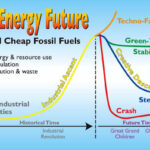Revolt and Change our lives

It’s a sign of a really good essay when bits of it linger with you for days after you’ve read it and it keeps popping up in your mind. Naomi Klein’s “Why Science is Telling All of Us to Revolt and Change Our Lives Before We Destroy the Planet” is one of those. Her theme? “Global capitalism has made the depletion of resources so rapid, convenient and barrier-free that ‘earth-human systems’ are becoming dangerously unstable in response.”
“Serious scientific gatherings don’t usually feature calls for mass political resistance, much less direct action and sabotage,” Klein writes. She describes UC San Diego geophysicist Brad Werner at a major scientific conference as “observing that mass uprisings of people — along the lines of the abolition movement, the civil rights movement or Occupy Wall Street — represent the likeliest source of ‘friction’ to slow down an economic machine that is careening out of control.”
The part that keeps itching at me, days after I read Klein’s article, is the presumption that “mass uprisings” are the only way out of this mess.
“Increasing numbers of us are responding accordingly,” Klein writes, “blockading fracking activity in Balcombe; interfering with Arctic drilling preparations in Russian waters …; taking tar sands operators to court …; and countless other acts of resistance large and small.”
Ok. So once the protestors have stopped the drilling and the pipelines, who’s going to teach citizens the ways of an oil-free lifestyle? Right now we don’t have powerdown infrastructure in place. Once the protesters have slowed the conventional economic machine, what will we have left? We need to have a new economy in place. And somebody’s got to build it.
Joanna Macy sagely reminds us that there are three paths of action to help further The Great Turning. (video) Macy’s first is Stopping action, stopping further destruction, which is all that Klein talks about or labels as “appropriate.” Stopping action is noisy campaigning, it is Julia Butterfly Hill sitting in old-growth trees, it is Tim DeChristopher bidding on land parcels, it is the activists who lie down in front of the pipeline trucks.
Stopping actions capture the media attention and get the TV cameras rolling. But we need much more than noise and drama right now. Attention is nice, but I would venture that critical mass has already been reached. People in the street know we’ve got a problem. I hear confirmation of this in the wealthy “green” neighborhoods of WestLA, in the downtrodden streets of SouthLA, and my friend reports same from the Spanish-language street festivals: “What are we going to do about it?” people ask. We’re beyond awareness-raising. We need to lead in other ways as well.
Macy’s second type of action is Creating New Structures, creating that which will be in place to replace the old. Sound familiar? To those of us working with different facets of the international Transition movement it sure does. This is the “change our lives” part of the equation. It’s a much quieter type of action, in that it doesn’t necessarily mean noisy crowds with plackards out on the streets, and it doesn’t necessarily grab the notice of the news cameras. But it’s no less of a revolution. And it’s happening all around you right now.
Creating new structures is so very big right now that it hardly seems right to try to brand it as “transition.” It’s everywhere. It’s the new direction. Macy and a few others call it The Great Turning. Over the past year or so, in my public talks I’ve been calling it “the new future.” These changes are so widespread that the TV cameras CAN’T capture them. The numbers of people involved in creating these changes are so vast that no Occupy plaza is big enough to hold them.
A week ago, I went to the Los Angeles Community Gardens Council “Gathering of Gardens.” What struck me so powerfully was sitting in an elementary school auditorium for lunch and looking around me. Everyone in that room was a change-maker. Everyone there saw the problems and made the conscious decision to take action, each on their own facet of the problem. People in that room were attacking the problem from all angles: education in schools, social justice, food security, land use, zero waste. And the people in that room that day were only the project leaders — just a very small sampling of the vast numbers of people currently active in our local urban food transformation.
This past week I travelled to a small city miles to the north of Los Angeles. Taking a stoll down the street with my son at the end of the day, we happened upon the close-of-day for an open air festival. Or perhaps it was two festivals, across the street from each other, at two properties on the same day. On one side of the street were more than a dozen tables, people rolling up a banner for a holistic health fair. On the other side of the street, other people were cleaning up tables for Permaculture Credit Union and Bioneers Central Coast. It’s happening. All around us.
Meanwhile, the politicians. I have long been leery of politicians. (why?) But now local politicians are coming to us. They know change needs to happen — really big change — but to do it they need constituents to ask for it and to give it rational, calculated, steady support. In several separate instances over the past few months, we’ve had government coming to us asking for ideas and proposals. Meanwhile people like Andy Lipkis are patiently positioning to guide change in the huge systems at a massive, institutional, infrastructure level. Big, big change is quietly unfolding.
Some of us aren’t the personality type to shout and carry plackards on the street. Some of us are quieter revolutionaries, but no less revolutionary, building resistence — no, make that RESILIENCE — every single day. Deep, meaningful change — lifestyle change — happens with a different energy than protests. It operates on a different time scale. I tell people “it takes time to grow a garden.” It’s a poetic statement, not just about gardens, but about all that we do. It takes time to build a new economy. It takes time to get people skilled up in holistic health care. It takes time to build new infrastructure for water supply. The list goes on.
By “different time scale” I don’t necessarily mean “slower.” Perhaps slower at first, but it’s more like one of those curvy graphs than a straight linear accelleration. It takes time to gain traction, for the quiet welling-up part, but then all of a sudden it pops wide open with a quiet WHUMP like an umbrella opening, and the new practices are all around you.
The quiet welling-up doesn’t capture the attention of the sound-bite-driven conventional media. That’s why you rarely hear about it, unless you go looking for the good news stories. Conventional media isn’t a good way to judge what is happening in the world. Especially right now, in this time when such massive-scale change is unfolding, beneath our very noses, in every corner of society.
Which brings me to Macy’s third type of action to help further The Great Turning: Change in Consciousness. Joanna Macy describes this as changing the stories we tell each other, our cultural stories, our inner stories. Redefining who we are, and how humanity fits into the cycles of this small planet. Within the international Transition movement, this is addressed as “inner transition.” Changing our inner selves, our inner paradigm, our ways of relating to each other is another huge part of creating the world we want to live in.
Again, critical mass has been met. People feel it in their guts: the dischord between the glittery hollow world portrayed in corporate advertisements and corporate-controlled conventional media, versus the harsh realities of a nonfunctional-economy, mounting examples of climate change, pollution, the burden of too-much-stuff, the stress and stress-based illnesses of the conflict they’re living. People feel it. It’s time to acknowledge that discord, put a name on it, and begin creating the foundations of the new consciousness. It’s time to start creating the way we want the new future to feel, deep inside.
One small step I’m taking this November is to participate in the 21 Days of Gratitude Challenge that is making its way around the internet. Yes! Magazine endorsed it. Several big name activists are joining in. (21 Days of Gratitude Challenge:social media oriented version; pdf/relatively-offline version; Yes! Magazine article; inspiring video; acts of kindness.)
I could use more gratitude in my life. I need to cultivate that “garden.” I’ll start now: I’m grateful for Naomi Klein, her powerful ideas that catch fire and capture peoples’ attention, and her laser-sharp observations about society. I thank her for her ongoing work, and hope she doesn’t stop speaking up.
Meanwhile, I’m more of a quiet revolutionary. I’ve found my niche, and my style of resistance and revolt is much more along the lines of Macy’s “creating new structures.” It feels right to me. And we’re getting a tremendous lot of much-needed, very real change accomplished.
Read more about the Transition Movement and social change

